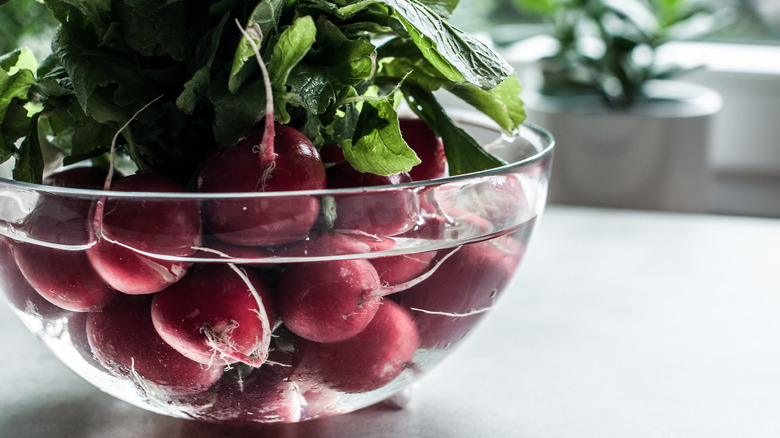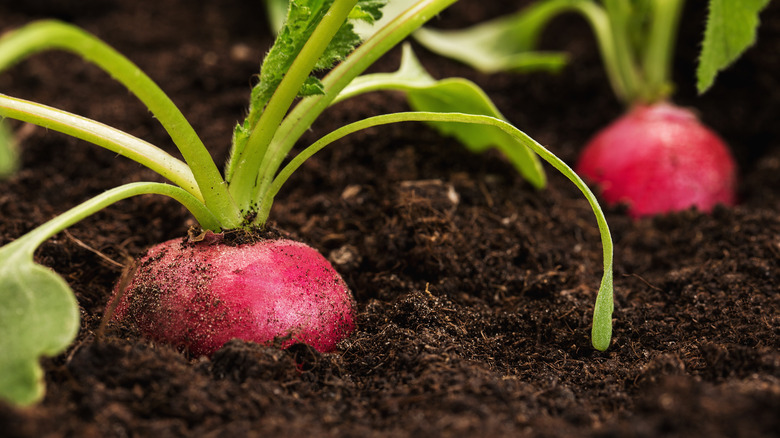Should You Store Radishes In Water?
For those of us who don't cook them often, radishes can pose a storage conundrum: Should they be kept on the kitchen counter, in the fridge, or somewhere else entirely? The main objective is to keep them crisp, and it turns out that the trick for storing baby carrots to keep them crunchy for weeks also works with radishes. You simply have to submerge them in water and keep them in the fridge.
While you might expect water to turn radishes mushy and inedible, it actually does the opposite. Some vegetables like spinach can rot rapidly in contact with water, but a full bath helps sturdy radishes stay crispy and fresh, staving off degradation for up to two weeks. You'll need to change out the water every couple of days and keep the container covered to limit any potential bacterial growth, but other than that, this solution is pretty much foolproof.
If you don't have room in your fridge for a water-filled bowl or container, you can also wrap your radishes in a damp paper towel or dishcloth, then store them in an airtight bag. Using this method, you can easily store your radishes in the crisper drawer with other veggies, but keep in mind they may only last up to a week.
Additional tips for storing radishes in water
For best results, you can take a few additional steps before storing radishes in water. First, wash the veggies — even though they're going to be submerged in water, you don't want them to soak in their own dirt and debris. You should also remove the leaves, stems, and roots, as these parts can quickly become waterlogged and moldy. Last but not least, place the radish bulbs in a container of cold water and seal tightly before refrigerating.
These tips are subject to change for alternative storage methods. If you choose to store your radishes in a bag instead of fully submerging them, you should forgo washing. Too much moisture can build up in the bag, and combined with air exposure, it can turn your radishes mushy. However, you should still remove all other parts of the plant besides the bulbs.
If you know you'll be using your haul of radishes within a day or so, or you simply have no fridge space, you can get away with storing them on the countertop. Wash off any excess dirt, but leave the leaves and roots intact. Next, place the radishes upright in a bowl or container, filling it partially with cold water so the bulbs are submerged, but the leaves are dry. Change the water every couple of days to maintain freshness, though it's best to use the veggies ASAP. Easy ideas include a radish and citrus salad recipe or simple pickle.
Ways to store radishes that don't involve water
Although submerging radishes in water is the best storage solution, there are simpler (and still effective) ways to keep them. If you're storing your radishes in the fridge, you can swap out the damp paper towels and sealed bag for a breathable vegetable bag or a perforated plastic bag. These vessels will hold in moisture, while also allow for some level of air circulation, which keeps radishes from drying out or turning soggy.
Alternatively, you can store big batches of whole radishes as-is in a basement or cellar. You might place them in a crate alongside your cardboard box of potatoes and loosely cover them with dirt or sand. Like the water and refrigeration method, this keeps the radishes cool and moist. If you don't have mulch to spare, you can also swap out the dirt for a simple mesh bag and achieve similar results without the mess.
Yet another option is freezing radishes for long-term storage. To allow for even freezing and thawing, you'll first need to chop up the veggies, then quickly blanch them in boiling water to preserve their texture. Transfer the radishes to ice water, dry them, and package them to lay flat in the freezer. You'll have a little piece of spring's bounty for the cold winter months.



